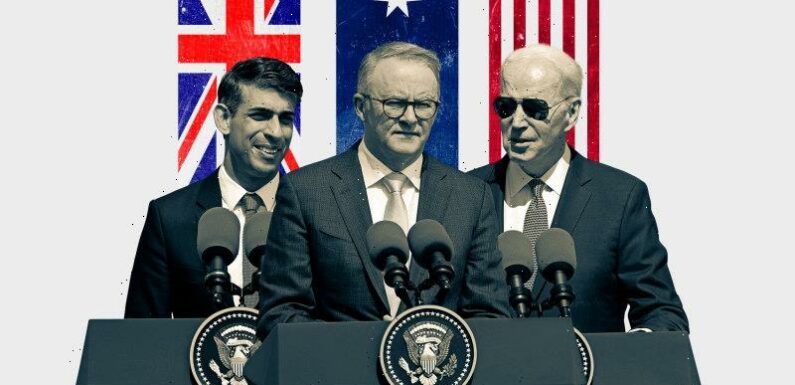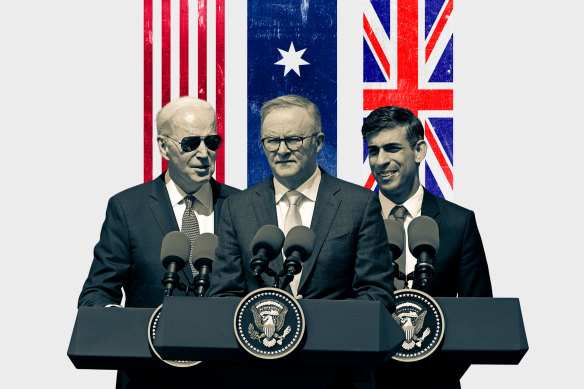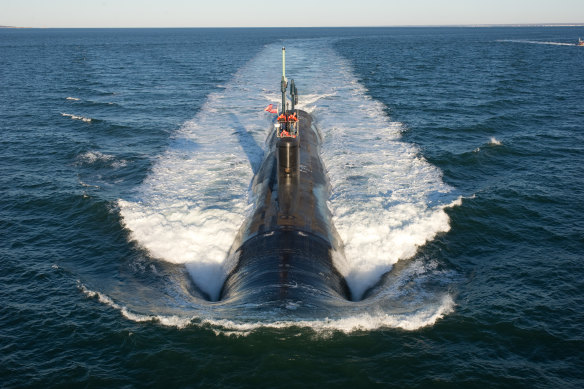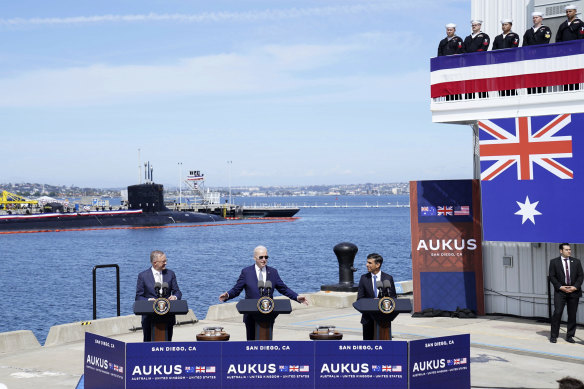
Eighteen months after signing the AUKUS pact, Australia has announced its biggest military spending since World War II. How will it work?
From a naval base in San Diego, Prime Minister Anthony Albanese unveiled the details of Australia’s biggest-ever defence investment. Floating behind, just in frame, was the reason: a multi-billion-dollar US nuclear submarine. This technology is one of the States’ most closely guarded secrets, shared with just one other nation, Britain (during the Cold War) and still considered a class above China’s rapidly growing submarine fleet.
Under the AUKUS pact sealed in 2021 with the US and the UK, Australia will acquire its own nuclear-powered fleet – first by buying between three and five US Virginia-class attack subs in the 2030s, and then by building eight new ships in Adelaide using a hybrid of UK and US tech that will come online in the 2040s.
It’s Australia’s biggest jump forward in military capability since the end of the Second World War, the government says, expected to cost up to $368 billion over the next 30 years. And it’s part of a high-stakes plan to help the US counter Chinese aggression in the Asia-Pacific that will soon see Australia regularly host American and British nuclear subs in its waters.
Of course, Australia’s nuclear-powered subs won’t be carrying any nuclear weapons. But they will elevate our military power on the world stage – allowing our subs to reach as far into the Indo-Pacific as the South China Sea and the East China Sea. Still, some experts see the big spend as a big gamble. So, what are we buying? How will it all work? And what’s the diplomatic response?
Joe Biden, Anthony Albanese and Rishi Sunak. Credit:Artwork Stephen Kiprillis, photography Alex Ellinghausen
What is AUKUS again, and what’s it about?
AUKUS stands for Australia, the UK, and the US. “It’s an unusual name, AUKUS, but it’s a powerful entity,” said US President Joe Biden as he stood with Albanese and British Prime Minister Rishi Sunak in San Diego, the home of the US Pacific fleet, to announce the results of 18 months of negotiations since the pact was signed.
Technically, AUKUS is a technology-sharing agreement, a series of defence projects between the allies rather than a new military alliance itself. While there’s been talk of developing and acquiring all kinds of tech, from quantum computers to undersea drones, the first task is building Australia a nuclear fleet “on the fastest timetable possible”, Biden said, to help secure the stability of the region in an uncertain time – what he called an “inflection point in history” but which Sunak named as a “dangerous” moment amid Russia’s invasion of Ukraine and China’s “growing assertiveness”.
The idea of giving Australia “the crown jewels” of US military technology had been floated, and shot down, many times down the years. But the rise of China in the Pacific – its militarisation of the South China Sea – has changed the calculus in Washington. . And, after years of Australia insisting it wouldn’t have to choose between its closest military ally (the US) and its biggest trading partner (China), the middle power has effectively thrown its lot in with America in the great superpower rivalry.
The surprise AUKUS announcement in 2021 drew outrage not only from China but France too – Australia had already been shopping around to replace its existing ageing fleet of conventional Collins submarines. The Morrison government of the time tore up an existing multi-billion-dollar deal with a French company for 12 diesel submarines in favour of the US option, in a back-door move French President Emmanuel Macron called a betrayal.
Back then, it seemed unlikely nuclear subs could even be built before the Collins subs are retired later this decade (or there is a potential Chinese move on Taiwan). But “this [announcement] is better than we thought we’d get”, says international security expert Professor John Blaxland at ANU. Not only will Australia buy US subs as it builds up its industrial capacity at home, but US and UK nuclear submarines will begin permanent rotations at Australia’s Perth naval base from 2027, with visits stepping up as soon as this year. “So it fills that capability gap.”
A Virginia-class attack submarine.Credit:US Department of Defense
Why do we need nuclear submarines?
Nuclear-powered submarines are the “apex predators” of navies. They’re faster and stealthier than conventional diesel models – designed to hunt other subs and run covert missions in enemy waters – and they can fire on land and sea targets. Only six countries in the world have them right now: the US, China, Russia, India, the UK and France. Just one ship costs a few billion dollars and requires millions of labour hours to build. But they never need refuelling – each submarine has its own miniature nuclear reactor on board, using highly enriched uranium, that lasts for the life of the ship.
A conventional diesel-powered sub has to resurface every few days, bringing in air to run its generators (known as snorting). That leaves it vulnerable to detection, “especially these days with satellites and drones,” says Blaxland. But a nuclear sub can stay below the waves for months on end, generally coming up only to refresh its crew. Though it’s possible to spot them using advanced thermal imaging (via the hot water their reactors discharge), nuclear submarines are famously quiet – so quiet that in 2009 British and French nuclear subs carrying ballistic missiles accidentally ran into each other in the Atlantic Ocean. “You really have to be in the right place at the right time to catch them,” says Blaxland.
Australia has long run undersea patrols close to home but, for travelling and defending further out in a more unstable Pacific, conventional submarines “won’t cut it”, Blaxland says. In light of the new AUKUS timeline, he expects a planned $6 billion project to extend the lives of our existing Collins subs by another decade to be abandoned.
What are we spending the money on?
First, the US will sell Australia three Virginia-class submarines to arrive in the early 2030s, and up to two more if required, Biden confirmed. The US and Australia are still working out if they will be newly built, or high-quality secondhand “rebadged” models. The US is already struggling to meet its own targets for submarine building back home and US Congress will need to approve the sale. But “they definitely won’t be clunkers,” according to one of America’s biggest proponents of the AUKUS deal, Democrat Joe Courtney. Defence Minister Richard Marles has since confirmed that the first submarine purchase will be secondhand, with 20 years left, but the others may be new. (Virginia-class subs have a life of about 33 years, suggesting the ship will be a decade old when it comes to Australia.)
Biden has stressed the new AUKUS boats will not have nuclear weapons of any kind, and Australia will not produce the nuclear fuel required to run them. Indeed, Australia will become the first state without nuclear weapons to acquire a nuclear-powered submarine fleet, but has promised to honour all its commitments under the nuclear non-proliferation treaty. The subs will carry conventional missiles and weapons though, offering more firepower than the Collins.
Meanwhile, Australia and the UK will begin work on a new class of submarine, to be known as the SSN-AUKUS. These “Franken-subs” are a British design using US technology, including its nuclear reactor and weapons system (though Rolls-Royce could build the reactors on the British side, according to Financial Times).
The UK plans to deliver the first SSN-AUKUS to its navy by the late 2030s, and Australia will begin construction in Adelaide later this decade to deliver the first boat by the early 2040s. From then on, one sub is expected to be built every two years in Australia until the late 2050s, giving us eight in total (in addition to the Virginias).
Blaxland calls it a suitably ambitious timeline to match what is a “risky endeavour”. “It makes sense.” While experts say the US still leads the way in naval technology, China now has the largest fleet in the world (on the number of ships), including a dozen nuclear submarines. “We need nuclear propulsion to keep up,” Blaxland says.
How much will it cost?
Australia’s nuclear fleet is expected to cost between $268 billion and $368 billion by 2055. That’s even higher than speculation by think tanks (of around $100 to $200 billion) in recent days, as details of the ambitious scheme began to leak.
But the government believes the budget bottom line won’t take a huge hit once savings from tearing up its previous contract for conventional French submarines are factored in. Estimates for that plan blew out to between $145 billion and $225 billion over its total life, and the Albanese government says $24 billion had already been put aside for it over the next decade (although $820 million of that has now gone to compensating the French company that had already begun work on those diesel subs.)
The government also plans to make $3 billion in cuts to other parts of the defence budget – what Marles calls restructuring around the AUKUS deal. Treasurer Jim Chalmer has acknowledged the project is a big cost, but has said the Labor government is being more upfront on the figures than the Coalition was on its own French subs deal by factoring in the additional cost of training too. And “Australia can’t afford not to do this,” he has said.
Long-term, the subs project will cost about 0.15 per cent of GDP each year, and total defence spending will surpass 2 per cent of GDP.
That may seem modest, as Marles says. But, to Swinburne business expert Aron Perenyi, it “points towards a level only seen at the height of the Cold War where Australian military expenditure was as high as 4 per cent of GDP”. “At the same time, Australia’s two-way trade with China is at approximately 19 per cent of Australian GDP [today],” he says. If tensions grow and trade deals only recently repaired with China fray once again, the cost of subs could hit Australia’s economy in other ways, he says.
Still, the plan, begun under Morrison and since accelerated by Albanese, has bipartisan support. Opposition leader Peter Dutton says the Coalition will back tough budget cuts to fund it, including to the National Disability Insurance Scheme, though it’s unclear how the spend will be received by the broader Australian public during the current cost-of-living squeeze.
Short term – over the next four years – the price tag is $9 billion, including $3 billion to underwrite construction of extra Virginia-class submarines in the US (and a fraction to boost UK shipbuilding), $2 billion for infrastructure in Adelaide and $1 billion for an expanded naval base in Perth to house US and UK ships.
The US, meanwhile, will commit $US4.6 billion to its own shipbuilding industry to speed up the Australian project, and the UK will spend £2.2 billion on its shipyards. Sunak has announced Britain will uplift its own defence budget from 2 per cent of GDP to a new target of 2.5 per cent.
How will it work?
Australia says it will retain sovereignty over all its new nuclear submarines, but it does not yet have a developed nuclear industry – or a local workforce of specialists to build and crew them. The Prime Minister says Australian personnel are already embedded with US and UK nuclear fleets to kickstart what will be a mammoth training campaign over the coming years. The defence spend will create an estimated 20,000 jobs, including 8500 directly involved in submarine building and technology, and scientists expect spin-off benefits for research too.
“The scale, complexity and economic significance of this investment is akin to the creation of the Australian automotive industry in the post-World War II period,” Albanese said.
In the US, Congressman Courtney says progress is also being made to clear a path for Australia through its maze of regulations and export control laws. But Congress will still need to sign off on the unprecedented sale of US subs to its ally.
Defence expert Peter Dean, one of the authors of the Australian Defence Force’s highly anticipated strategic review, supports the plan even as he notes the risks. For one thing, the very structure of the arrangement could mean Australia is operating three different kinds of submarines at one point. That would likely “prove enormously expensive and difficult in terms of maintenance, sustainment, training, and operations”. (Marles has said the differences between the Virginias and the new AUKUS ships won’t be insurmountable, and “crossovers” between models have been managed before.)
To Dean, “the holy grail of a true trilateral collaboration would be a common design and build in all three countries and production lines producing submarines in continuous builds across two US yards and one each in Australia and the UK.”
Some experts have also raised nuclear safety concerns as Australia takes carriage of such complicated technology. On that point, Marles says, “the sealed nuclear reactor is our friend”. Self-contained reactors will ensure safe oversight of each piece of nuclear equipment, he says. The federal government has committed to managing the radioactive waste generated from the submarines, including spent nuclear fuel, in Australia. Reactors will be disposed of on remote defence land, Marles says, starting from the 2050s when the first submarines are likely retired, though he did not say where or if that might include future land acquisitions.
Anthony Albanese, Joe Biden and Rishi Sunak announce the AUKUS deal.Credit:Stefan Rousseau
What of the diplomatic fallout?
Short-term, this move will likely inflame tensions, even if the AUKUS leaders stress it is designed to preserve stability in the region long-term.
Marles has spoken of a huge diplomatic effort behind the scenes, involving 60 phone calls between government ministers and leaders in the Pacific, ASEAN and the Five Eyes intelligence-sharing partnership (and to France). But already friendly nations and allies such as New Zealand have voiced unease. A briefing had also been offered to China, Marles said, but the government had not heard back.
“My government is determined to invest in our defence capability,” Albanese said. “But we’re also determined to promote security by investing in our relationships across our region.”
Blaxland has argued that AUKUS will likely strengthen American resolve to stay in the Pacific, which most regional neighbours will welcome, even if they are reluctant to say so publicly.
In the days before the announcement, when details proved less than watertight and speculation grew, China stepped up its rhetoric against the US. Chinese President Xi Jinping recently took the rare step of attacking the US by name when he accused America of “all-round containment, encirclement and suppression against us”.
Soon after, China’s new Minister for Foreign Affairs, Qin Gang told his first press conference, “If the US does not hit the brakes, and continues to speed down the wrong path, no amount of guardrails can prevent derailment.” China has since said that the AUKUS plan “undermines international non-proliferation system, fuels arms races, and hurts peace and stability in the region”.
But many Australian experts say Western countries are right to step up their deterrence capability, not just their own rhetoric, as the world faces its most uneasy geopolitical landscape since the Cold War.
Reflecting by the water in San Diego, US Ambassador to Australia Caroline Kennedy summed up the AUKUS gambit this way: “It’s historic for Australia because the US is sharing our most sensitive technology … but it’s historic for the United States as well because Australia is just emerging as such a significant ally. I mean, it always has been. But this is really going to take it to another level.”
Fascinating answers to perplexing questions delivered to your inbox every week. Sign up to get our Explainer newsletter here.
If you'd like some expert background on an issue or a news event, drop us a line at [email protected] or [email protected]. Read more explainers here.
Most Viewed in Politics
Source: Read Full Article


